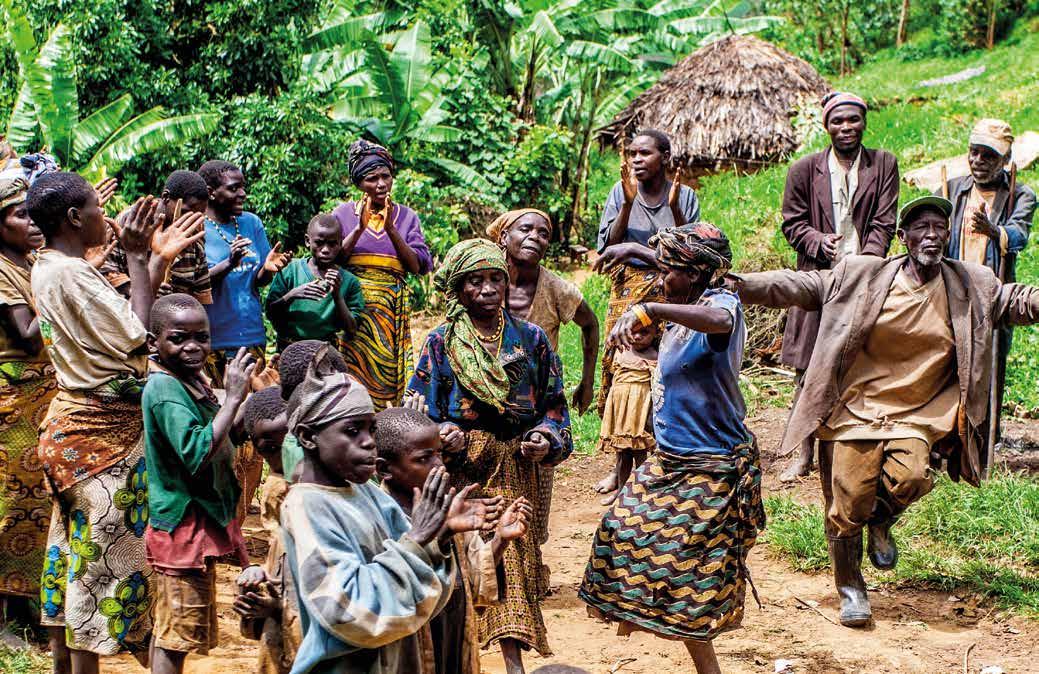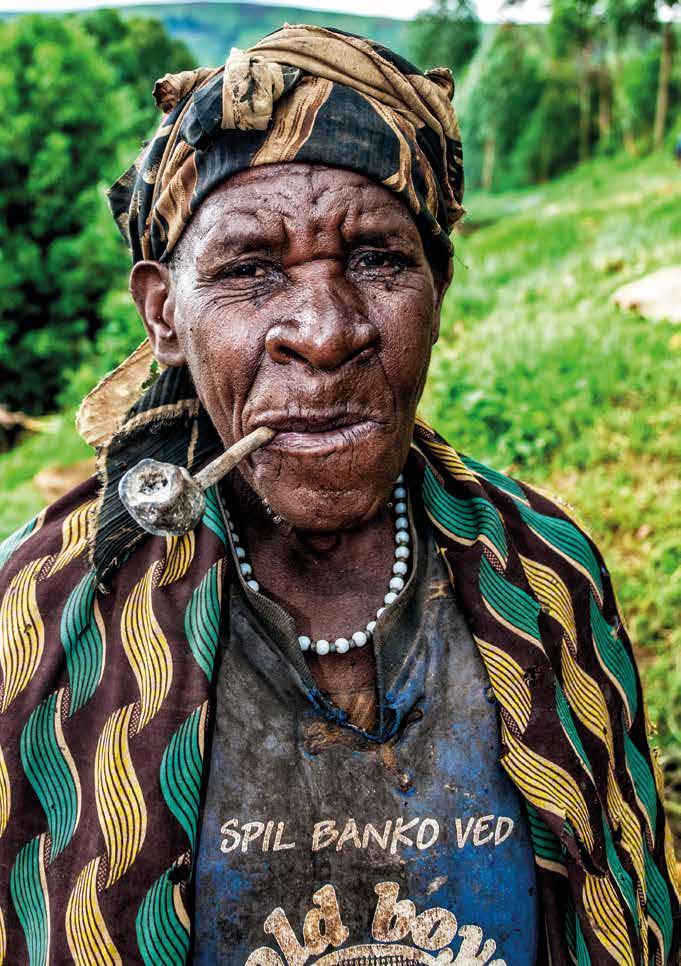
7 minute read
KEEPERS OF THE FOREST
KEEPERS
of the
Advertisement
The Batwa are an amazing indigenous group of people with excellent and interactive cultural experiences that one would not want to miss while visiting Uganda.
FOREST
The Batwa, or Twa, commonly known as pygmies, are an enchanted group of people around Echuya Forest Reserve in Kisoro and Kabale districts of South-Western Uganda. The Echuya is located in the Albertine Rift and recognised as an important eco-region and top birding destination. The Batwa are believed to have migrated from the Ituri Forest of the Democratic Republic of Congo in search of wild animals to hunt, hence the name Kisoro, literally translating to “the area occupied by wild animals”.

The Batwa, regarded as the “keepers of the forest”, co-existed peacefully with all creatures including mountain gorillas, until their haven was gazetted as Mgahinga Gorilla National Park to conserve gorillas in 1991. The history of these small-statured people is long and rich. They survived by hunting small game using arrows or nets and gathering plants and fruit in the rainforest. They lived in huts constructed with leaves and branches, moving frequently in search of fresh supplies of food. Some anthropologists estimate that pygmy tribes such as the Batwa have existed in the equatorial forests of Africa for 60,000 years or more.
According to folklore, during creation, God gifted humanity differently; He gave some people vast lands, beauty and height, and gifted the Batwa with the forest. As such, they felt God had rejected them when the 6,700-strong Batwa community were evicted. Overnight, they had become trespassers on their own land. Forced out and threatened with imprisonment, they moved to the fringes of the park, where they are now illegal squatters. Their tools and skills were not useful in the new modern environment, so most of them resorted to doing odd jobs, begging, poaching and even stealing.
Traditionally, the Batwa had three main types of houses: caves, omuririmbo and ichuro. The caves and omuririmbo were the main houses where they lived. Ichuro was used for resting and storing food including meat, honey, beans and sorghum. They were exceptional hunters, traditional healers, rainmakers, and still make fire by rubbing small sticks together. They had a special way of worshipping and offering sacrifices, especially when thanking the gods after a successful hunt. Worshipping was mainly
done in sacred huts by elders anointed by grandparents. When they slaughtered an animal with a strange organ such as an abnormally tiny heart, they would worship the organ as a god.
The men and women used leaves and skins of animals, especially duikers and bushbucks, as clothing. The children dressed in small skins of young animals strapped at the shoulders, and women used the skins for beautification and to carry their children on their backs. The long sinuous creepers (emise) that hang from the trees best exemplify the Batwa’s connection with the forest. They would weave cords from them and use them to tie the animal skins around their waists, and pound fruit seeds from omuruguya (Carapa procera tree) to obtain an oily liquid which they smeared on their skin to make it soft. The elderly smeared their skins with animal dung to prevent sunburn.
After a successful hunt, a Mutwa would celebrate the achievement by naming his children after the animal or a location in the forest. When a Mutwa died, they were buried in a hut after digging a small hole and wrapping the corpse in grass. A medicine man would come by to cleanse the bereaved family members to prevent the deceased’s spirit from attacking them. After burial, the family would migrate to a far off place and never return.
According to customs, a Mutwa could not marry a non-Mutwa, and getting pregnant before marriage was forbidden. Marriages were arranged by parents, and gifts like beads, new and well-oiled animal skins, honey from stingless bees, beer brewed with honey, and meat were given to a girl’s family before marriage. The meat of the squirrel was always preferred since it was hard to hunt, and it was given to the mother-in-law. Adultery was prohibited.
The men smoked tobacco and opium when destined to propose marriage. According to them, opium smoked in the right amounts gave one the courage and sweet words to win the heart of the most beautiful woman in the village, and made the bride’s eyes appreciate the physical features of the groom. Many marriages among the Batwa owed their fruition to smoking a pipe, and still do.
When a woman was pregnant, she was fed on meat, honey, vegetables and herbs to boost her health and that of the unborn baby. During childbirth, fellow women used pieces of bamboo to cut the umbilical cord before the baby was wrapped in clean animal skins and taken near a fireplace for warmth. A bow and arrow was placed in a newborn’s palms as a sign of protection. Sadly, this way of life is vanishing.
But all is not lost. In 2000, members
of the community formed the United Organisation for Batwa Development in Uganda (UOBDU), which works to support the tribe in areas such as education, housing, and income generation. Together with Uganda Wildlife Authority, they set up cultural experiences during which visitors spend time with them, see how they live, and learn about the tools and tricks they used to survive for centuries in Uganda’s tangled forests.
Right:
Batwa children are now attending school and learning to read and write

Visiting the Batwa
A magnificent opportunity to experience the forest through their eyes, this is a full-day adventure organised in two tours - the Batwa Cultural Experience at Bwindi, and the Batwa Cultural Trail at Mgahinga. Before the trail, the guide (a Mutwa), dressed in
traditional attire, kneels down and chants an ancient prayer to Biheeko, god of the forest, praying for a blessing throughout the walk.
In Bwindi, the experience starts at a Batwa homestead, where after a warm welcome, your one-hour cultural immersion will begin. You will observe how the women prepare, cook and serve a meal, and engage with medicine men to learn about the medicinal properties of the lush forest flora.
You will learn about the Batwa’s fascinating way of life; from religion, food gathering and hunting techniques to fire-making skills, as well as music performed on wooden instruments and animal-skin drums. You’ll also learn how they build their huts, including the high-up ‘nests’ they build in trees to protect small children from marauding predators. Finally, you can learn how bananas are used to make juice, beer and gin – and taste the results!
At Mgahinga you can take the Batwa Cultural Trail, a gentle fivehour nature walk through the forest accompanied by community guides, who will show you how they forage for food, trap animals with snares made from branches, and make tools and medicines out of plants. The climax of this trail is at Garama Cave, a 200m-long lava tube that was once a royal residence. This is where their king used to keep his virgins, captured from neighbouring kingdoms in Congo and Ankole during battle, and it was a hiding place for the entire tribe during warfare. Here, members of the tribe perform songs coined around the good old times, their strong voices reverberating through the dark hollow cave.
The money earned from these cultural excursions goes back to Batwa communities in the form of food, clothes, scholastic materials for children and medical services, all aimed at improving their standard of living. Similarly, the ventures are a source of employment for the Batwa people since they are the main participants as guides, dancers and porters.
What you need to know
On your arrival in the area, you might be approached by independent ‘guides’ offering to take you to a Batwa community. These unregulated tours may well be exploitative and should be avoided. Stick to official tours only – those run by the UOBDU, the Uganda Wildlife Authority, or the Batwa Development Programme. Ask at your accommodation or at the Batwa craft shop (close to the entrance to Bwindi) for more information.
The Batwa Culture Trail in Mgahinga costs $80, while the Cultural Experience in Bwindi costs $100. The grounds are muddy and slippery, and the forest weather is unpredictable. Travellers are advised to wear hiking boots, hats, rain jackets and sweaters, and carry walking sticks.
Spending time with the Batwa isn’t just a fascinating opportunity to learn about centuries-old nomadic forest living, but a rewarding introduction to a proud community that will leave you feeling both inspired and moved.
Compiled by Dora B. M.










